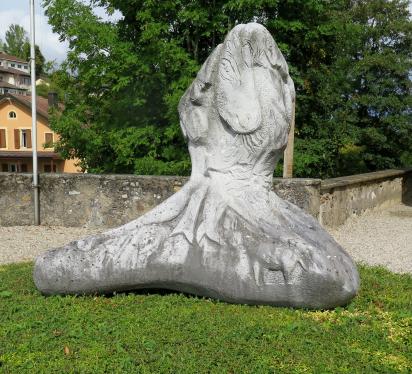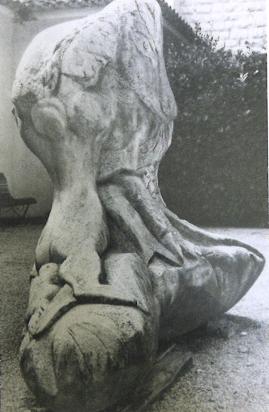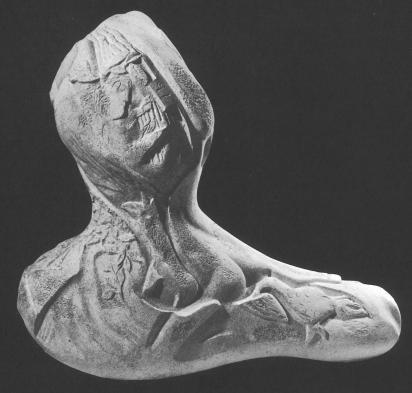Acquired in 1986 for Jersey City’s Liberty Harbor, where it was to stand at the center of a pool, the sculpture Mermaid or Song was instead placed in Grandson Castle, in Switzerland, until construction ended at the site. The governor in place at the time was very enthusiastic, stating: “It won’t just be fantastic for New York, it will be magnificent for all of America1.” Despite this positivity, Marc Chagall’s piece was never taken to the banks of the Hudson river, across from the majestic Statue of Liberty. Instead, it remained on the European continent.
The shape and composition of this monumental sculpture, the largest ever made by Chagall, look like a painted stone resting on a base, which indeed served as a mockup. Stones collected from the beach—mineral objects shaped by the sea, the atmosphere, and the weather—had inspired Chagall’s interpretation of the shape of this imposing marble, which was also exposed to the elements at Grandson Castle. The surface of the marble, with its magmatic undulations, is animated by human, animal, and plant shapes subjected to a mysterious articulation. A female torso in the upper portion of the sculpture, through contortion, finds its extension in the lower horizontal section, then morphs into a fishtail. Here, a couple against a backdrop of residential rooftops; there, a pair of bovine legs; elsewhere, a garland of finely chiseled leaves; further along, another face or another torso. Dynamic, complex, or even Baroque, the sculpture is a metamorphosis of bodies and patterns: “Here we are at the very source of all living images, in all forms, which, in their drive to be seen, mingle, bump into one another, cover each other. The living and the inert come together as one,” according to Charles Sorlier, in reference to Chagall’s sculpture.
In the upper portion of the sculpture, a male figure plays the lyre. It is Solomon, the King of Israel, to whom authorship of the Song of Songs is traditionally attributed. This poetic text from the Old Testament, known as the Song of Solomon, is also the basis for a series of pictorial works made by the artist between 1955 and 1960 and preserved at the Musée National Marc Chagall in Nice. A polyphony of lyric voices, alternating between female and male, emanates from these enigmatic verses—the most sensual in the Bible. Imbued with symbols and metaphors, the Song celebrates carnal love between a woman and a man, in a radiant communion with nature: “Let us go early to the vineyards / To see if the vine has budded, if the blossom has opened / If the pomegranates are in bloom. / There I will give you my love.” (Song of Solomon 7:13.) Through its living, moving shapes, Chagall’s sculpture seems to transcribe in marble the life force of nature and the melody of ages-old poetry.





